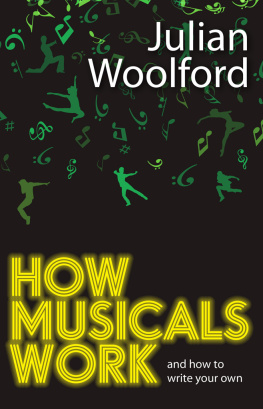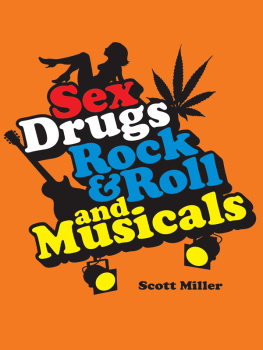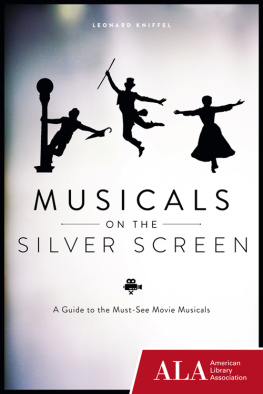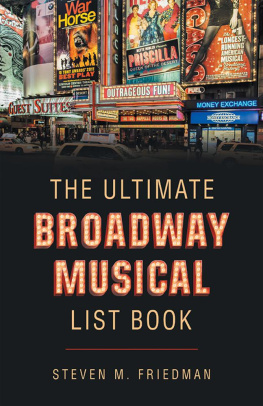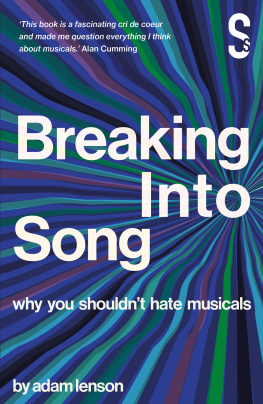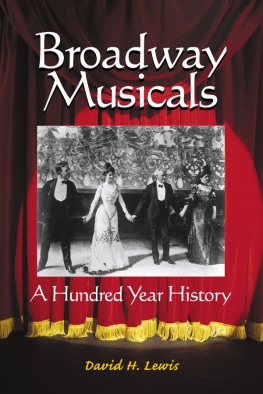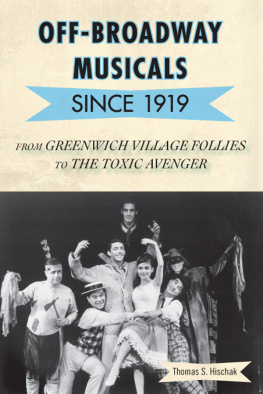How Musicals Work
and How to Write Your Own
Julian Woolford

NICK HERN BOOKS
London
www.nickhernbooks.co.uk
For Richard John,
withoutwhom my work is half-complete
and
StephenBarlow,
withoutwhom my life is half-complete
Beginnings

Beginnings
Musicals are like children. They are conceived out of an act of excitement, the pregnancy is long, frustrating and rewarding, birth can be very painful, raising them is an act of collaboration with many people, and, if you are very lucky, they will support you in your old age.
Writing a musical, like a pregnancy, will take your care and attention, it will often be demanding, it will fill you with love and it might even put a strain on your other relationships. It will tie you to the people you created it with for ever. But once you have created a musical, it will always be part of your life, and you should always be proud of it.
This book is, therefore, a prenatal guide for musicals. It will help you generate ideas to conceive your show, make sure that the skeleton is all in place and healthy, help you fill out the flesh and bones of the characters and help you finally see it born onstage in a living, breathing performance. It also has a section on how to put it to work and make it earn its living.
As the title suggests, this book also examines how musicals work. It looks at the storytelling and structure of some well-known musicals, and shows how the best musicals draw on ancient myths and tap into the human psyche to engage the audience. You cannot create great art until you understand how that art has been created in the past, even if you then work in your own idiosyncratic manner.
Like the creation of all arts, it is easy to write a bad musical. Some bad musicals even get produced and some of those shows even become hits. A bad painting can be walked past, bad novels can be put down, but bad theatre must be endured (at least for its running time!).
Shoddy work, ill-considered decisions and a lack of craft will generally mean that the work will not take its rank among those shows that are often revived. A true classic, like Sondheims Into the Woods, or Rodgers and Hammersteins Oklahoma!, will have a long and successful life. This book looks at how successful musicals work, gives an indication as to why some musicals fail and considers the ways in which writers can ensure that their musical will be as good as possible. It can help you understand how the musical you want to write can have truth and depth, and how it might be more likely that people will want to produce and perform your musical for a long time to come.
Writing a musical is 10 per cent inspiration and 90 per cent perspiration. It is a lot of hard work. This book is full of the techniques that I use to write, developed through working as a professional writer of musicals and plays, from my work as a theatre director, from working as a dramaturg for Mercury Musical Developments, and from teaching the creation of musical theatre for the University of London.
Exercises
Throughout this book you will find shaded boxes like this one. Each box contains an exercise that is designed to stimulate ideas and to make you really think about the musical you are writing. Do whichever of them interest you, but at least read them and consider the point of each of them. You might find it helpful to buy a copy of a libretto for a musical that you like, as some of the exercises involve analysing existing musicals. If you do them all, you will have enough ideas to last you a lifetime.
Before starting you should think about the type of musical you want to write and about what your distinctive, original voice will be. I often read musicals that are derivative of other works. It is no good setting out to write like Sondheim, Lloyd Webber or Jason Robert Brown: those three have already mastered those styles. You need to think about who you want to be as a writer. The techniques can be taught, but the combining of the techniques with your own unique talents is something that only you can do. Some of the biggest hits of recent years like Matilda, Avenue Q, Spring Awakening and In the Heights have come from writers who understand the art form, but have combined it with a distinctive voice. It is time to find yours.
What is a Musical?
For the purposes of this book, I define a musical as a theatrical presentation where the content of the story is communicated through speech, music and movement in an integrated fashion to create a unified whole. The written work is formed of three elements, the book, the music and the lyrics. The book is sometimes known as the script, and is the unsung sections of the work; the lyrics are the words that are sung. The book also refers to the character development and the dramatic structure of the work; together, the book and lyrics are called the libretto, which is Italian for little book. The music and lyrics together are referred to as the score.
The following diagram shows how the different terms relate to each other and overlap:

You will note that there is no word for the book and music together. Music that comes under spoken scenes is referred to as underscore, as it comes under the dialogue at a level at which the audience can still hear and understand what is being said.
Why Write a Musical?
The fact that you are reading this book probably means that you are interested in writing a musical, but have you taken a second to ask yourself, Why?
For some, there is a love of the art form. The best musical performances feature triple-threat performers who can sing, dance and act to a highly professional level, who can remain convincingly in character when combining all their skills and who can perform work that is thought-provoking, exciting, moving and stimulating. Along with opera, it is the most theatrical art form, and can deliver some stories better than any other. It is removed from real life yet capable of acting as a prism to it, transporting an audience to see sights and hear sounds they never imagined.
For some, the attraction is financial. The musical is the most commercial form of theatre. Broadway box-office income tops $1 billion every year, and this means that something in the region of $45 million of royalties is split between the writers of the twenty or so Broadway musicals playing at any time. That is before you take into account the national tours, the West End transfers and other overseas productions. If a writer of a musical mega-hit ever offers to buy you a drink, then let him because he can afford it. And if he ever offers to buy you a house, he can probably afford that too.
For some, the attraction is fame. Rodgers and Hammerstein, Andrew Lloyd Webber and George Gershwin are well-known names and this kind of recognition lights some peoples fires.
For me, the attraction is creative. I write musicals because I love the form. I love being able to tell a story in a truly theatrical fashion, and to be able to elevate the emotional content through song and dance. Musicals are often criticised for being unrealistic, that people do not suddenly burst into song and dance in real life. I live real life every day, and for me the attraction of the musical is its theatricality. I dont want to go to the theatre to see the ordinary everyday; I want to go for an elevated, emotional experience where a performer is able to connect with an audience using all the skills they possess.

